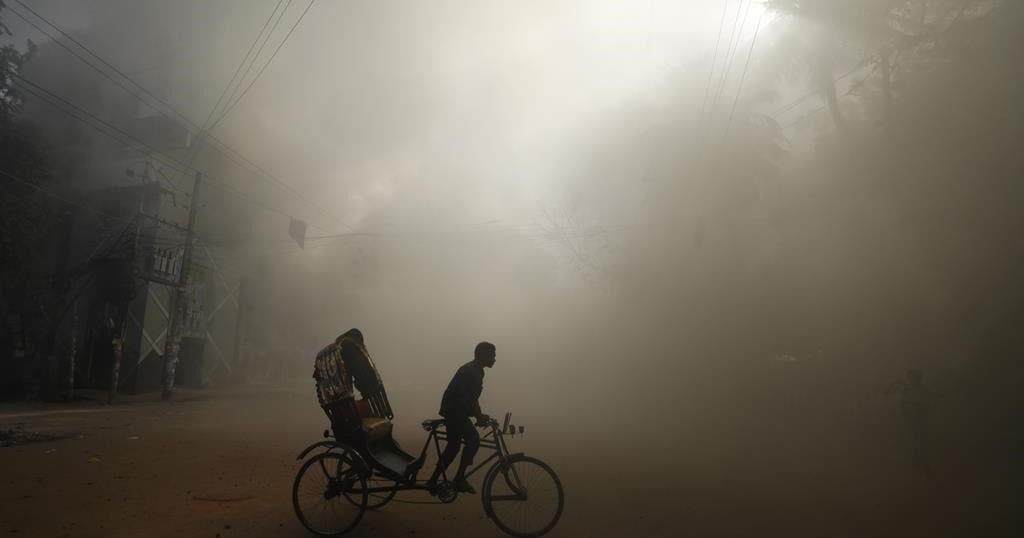DHAKA, Bangladesh (AP) — Bangladesh’s prime minister resigned and fled the country Monday, after weeks of protests against a quota system for government jobs descended into violence and grew into a broader challenge to her 15-year rule. Thousands of demonstrators stormed her official residence, a day after nearly 100 died in the unrest.
Prime Minister Sheikh Hasina’s departure threatens to create even more instability in the nation on India’s border already dealing with a series of crises, from high unemployment and corruption to climate change.
Hours after the embattled leader was seen on TV boarding a military helicopter with her sister, the country’s military chief, Gen. Waker-uz-Zaman, said he would seek the president’s guidance on forming an interim government.
He promised that the military would launch an investigation into the deadly crackdown on student-led protests that fueled outrage against the government.
“Keep faith in the military, we will investigate all the killings and punish the responsible,” he said. “I have ordered that no army and police will indulge in any kind of firing.”
He met opposition politicians, including the head of the now-banned Jamaat-e-Islami party, and civil society members before making his statement.
The protests began peacefully as frustrated students demanded an end to a quota system for government jobs that they said favored those with connections to the prime minister’s Awami League party, but the demonstrations have since morphed into an unprecedented challenge to Hasina and the party.
The 76-year-old — who was the longest-serving female head of government — was elected for a fourth consecutive term in a January vote that was boycotted by her main opponents. Thousands of opposition members were jailed in the lead-up to the polls, and the U.S. and the U.K. denounced the result as not credible, though the government defended it.
Hasina had cultivated ties with powerful countries, including both India and China. But under her, relations with United States and other Western nations have come under strain, as they have expressed concerns over human rights violations and press freedoms in the predominantly Muslim nation of 170 million people.
Her political opponents have previously accused her of growing increasingly autocratic and called her a threat to the country’s democracy, and many now say the unrest is a result of that authoritarian streak.
Hasina arrived Monday in a city in India on the border with Bangladesh in an army helicopter, according to a military official who spoke on condition of anonymity because he was not authorized to release the information to the media. It was not clear where she would go next.
As she fled, people stormed her residence, taking furniture and pulling food from the refrigerators.
Protests have continued even after the Supreme Court last month ruled that the quota system — which set aside up to 30% of government jobs for family members of veterans who fought in Bangladesh’s war of independence against Pakistan — must be drastically cut. The government attempted to quell the demonstrations with force, leaving nearly 300 people dead since mid-July.
At least 95 people, including at least 14 police officers, died in clashes in the capital on Sunday, according to the country’s leading Bengali-language daily newspaper, Prothom Alo. Hundreds more were injured.
At least 11,000 people have been arrested in recent weeks. The unrest has also resulted in the closure of schools and universities across the country, and authorities at one point imposed a shoot-on-sight curfew.
Authorities also shut off mobile internet on Sunday in an attempt to quell the unrest, and broadband internet was cut briefly Monday morning. It was the second internet blackout in the country since July, but services were restored later Monday.
Over the weekend, protesters called for a “non-cooperation” effort, urging people not to pay taxes or utility bills and not to show up for work on Sunday, a working day in Bangladesh. Offices, banks and factories opened, but commuters in Dhaka and other cities struggled to get to their jobs since much public transport was halted amid fears of violence.
Hasina offered to talk with student leaders on Saturday, but a coordinator refused and demanded her resignation.
Hasina repeated her pledges to investigate the deaths and punish those responsible for the violence. She said she was ready to sit down whenever the protesters want. Earlier, she had said protesters who engaged in “sabotage” and destruction were no longer students but criminals, and that the people should deal with them with an iron hand.
___
Pathi reported from New Delhi.
























